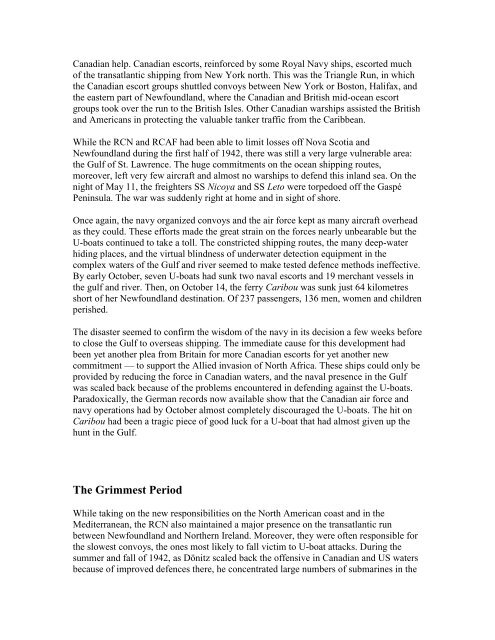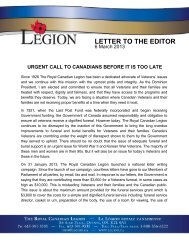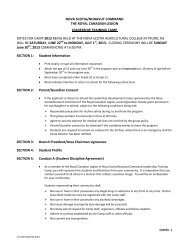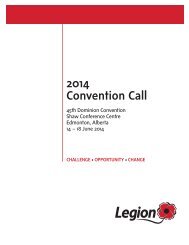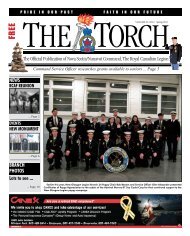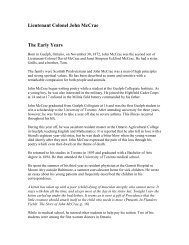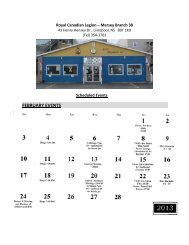Introduction The Battle of the Atlantic - Royal Canadian Legion
Introduction The Battle of the Atlantic - Royal Canadian Legion
Introduction The Battle of the Atlantic - Royal Canadian Legion
You also want an ePaper? Increase the reach of your titles
YUMPU automatically turns print PDFs into web optimized ePapers that Google loves.
<strong>Canadian</strong> help. <strong>Canadian</strong> escorts, reinforced by some <strong>Royal</strong> Navy ships, escorted much<strong>of</strong> <strong>the</strong> transatlantic shipping from New York north. This was <strong>the</strong> Triangle Run, in which<strong>the</strong> <strong>Canadian</strong> escort groups shuttled convoys between New York or Boston, Halifax, and<strong>the</strong> eastern part <strong>of</strong> Newfoundland, where <strong>the</strong> <strong>Canadian</strong> and British mid-ocean escortgroups took over <strong>the</strong> run to <strong>the</strong> British Isles. O<strong>the</strong>r <strong>Canadian</strong> warships assisted <strong>the</strong> Britishand Americans in protecting <strong>the</strong> valuable tanker traffic from <strong>the</strong> Caribbean.While <strong>the</strong> RCN and RCAF had been able to limit losses <strong>of</strong>f Nova Scotia andNewfoundland during <strong>the</strong> first half <strong>of</strong> 1942, <strong>the</strong>re was still a very large vulnerable area:<strong>the</strong> Gulf <strong>of</strong> St. Lawrence. <strong>The</strong> huge commitments on <strong>the</strong> ocean shipping routes,moreover, left very few aircraft and almost no warships to defend this inland sea. On <strong>the</strong>night <strong>of</strong> May 11, <strong>the</strong> freighters SS Nicoya and SS Leto were torpedoed <strong>of</strong>f <strong>the</strong> GaspéPeninsula. <strong>The</strong> war was suddenly right at home and in sight <strong>of</strong> shore.Once again, <strong>the</strong> navy organized convoys and <strong>the</strong> air force kept as many aircraft overheadas <strong>the</strong>y could. <strong>The</strong>se efforts made <strong>the</strong> great strain on <strong>the</strong> forces nearly unbearable but <strong>the</strong>U-boats continued to take a toll. <strong>The</strong> constricted shipping routes, <strong>the</strong> many deep-waterhiding places, and <strong>the</strong> virtual blindness <strong>of</strong> underwater detection equipment in <strong>the</strong>complex waters <strong>of</strong> <strong>the</strong> Gulf and river seemed to make tested defence methods ineffective.By early October, seven U-boats had sunk two naval escorts and 19 merchant vessels in<strong>the</strong> gulf and river. <strong>The</strong>n, on October 14, <strong>the</strong> ferry Caribou was sunk just 64 kilometresshort <strong>of</strong> her Newfoundland destination. Of 237 passengers, 136 men, women and childrenperished.<strong>The</strong> disaster seemed to confirm <strong>the</strong> wisdom <strong>of</strong> <strong>the</strong> navy in its decision a few weeks beforeto close <strong>the</strong> Gulf to overseas shipping. <strong>The</strong> immediate cause for this development hadbeen yet ano<strong>the</strong>r plea from Britain for more <strong>Canadian</strong> escorts for yet ano<strong>the</strong>r newcommitment — to support <strong>the</strong> Allied invasion <strong>of</strong> North Africa. <strong>The</strong>se ships could only beprovided by reducing <strong>the</strong> force in <strong>Canadian</strong> waters, and <strong>the</strong> naval presence in <strong>the</strong> Gulfwas scaled back because <strong>of</strong> <strong>the</strong> problems encountered in defending against <strong>the</strong> U-boats.Paradoxically, <strong>the</strong> German records now available show that <strong>the</strong> <strong>Canadian</strong> air force andnavy operations had by October almost completely discouraged <strong>the</strong> U-boats. <strong>The</strong> hit onCaribou had been a tragic piece <strong>of</strong> good luck for a U-boat that had almost given up <strong>the</strong>hunt in <strong>the</strong> Gulf.<strong>The</strong> Grimmest PeriodWhile taking on <strong>the</strong> new responsibilities on <strong>the</strong> North American coast and in <strong>the</strong>Mediterranean, <strong>the</strong> RCN also maintained a major presence on <strong>the</strong> transatlantic runbetween Newfoundland and Nor<strong>the</strong>rn Ireland. Moreover, <strong>the</strong>y were <strong>of</strong>ten responsible for<strong>the</strong> slowest convoys, <strong>the</strong> ones most likely to fall victim to U-boat attacks. During <strong>the</strong>summer and fall <strong>of</strong> 1942, as Dönitz scaled back <strong>the</strong> <strong>of</strong>fensive in <strong>Canadian</strong> and US watersbecause <strong>of</strong> improved defences <strong>the</strong>re, he concentrated large numbers <strong>of</strong> submarines in <strong>the</strong>


